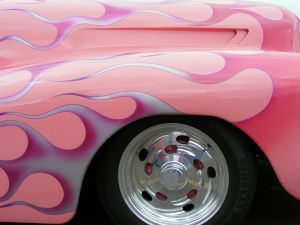When I was a kid, I took popcorn balls to school for Halloween, Christmas and Valentines Day parties. My classmates would beg me to bring them. My mom took a huge punch bowl, filled with popcorn balls and offer them to any visitor that would stop by. My grandfather would tuck them amongst the branches of the Christmas tree and they always ended up in our Christmas stockings as well. Learning how to make popcorn balls is a lesson in perfecting techniques more than finding the perfect recipe. Once you know how to work with “cooked sugar,” you’ll be able to decide whether you want to make “ooey-gooey” popcorn balls, or popcorn balls that are crispy and light.
How to Make Popcorn Balls: The Popcorn
Very few of us know how to make popcorn on the stove top. It’s simple enough, but it requires a little practice to get the hang of it. You could use microwave popcorn, but that raises the cost of the popcorn ball substantially. The best investment I ever made was in an air popcorn popper — $10 on Ebay! I only use it for popcorn balls, but since popcorn balls are a Halloween, Christmas, Easter and 4th of July tradition, it gets more action than our toaster.
Before you start popping your corn, preheat your oven to 250 degrees.
If you chose to use microwave popcorn, choose the plain – WITHOUT BUTTER – popcorn. A little salt is okay. And, if you pop your own popcorn, don’t add any butter. It can make your popcorn soggy and limp after a few hours. And the sugar syrup might have a problem setting up nice and crispy.
After you make your popcorn, you need to separate out all the un-popped kernels. Really. Don’t skip this step. You don’t want anyone to break a tooth. You can dump the popped corn into a colander and the kernels will fall through the holes.
Or you can try my no fail method: Shake the popped corn. Using a wire Chinese skimmer or your two freshly washed hands, gently lift the top layer of the popped corn and transfer it to another large bowl or pan. A big turkey roasting pan is perfect for this. Continue shaking and lifting until you reach the bottom and see all the un-popped kernels (also known as Old Maids). Don’t bust up the popcorn. You want your popcorn balls to be light and fluffy and broken bits are not conducive to that.
Keep the freshly popped corn in your warm oven. Not only does it stay crisp, but hot popcorn lengthens the working time you’ll have, once you pore on the sugar concoction.
How to Make Popcorn Balls: Karo Syrup
My favorite popcorn ball recipes call for the use of Karo Syrup. Back in the day, there was no “generic” corn syrup. Today, you can get Light Karo and Dark Karo. The syrups are interchangeable. Dark Karo has a stronger molasses flavoring, and your sugar solution will be a little darker in color. That’s the only difference.
You may also find “Lite” Karo syrup. This has fewer calories but I could not recommend it for popcorn ball making because I have never used it. I don’t know if it would behave the same way as regular Karo Syrup when boiled.
How to Make Popcorn Balls: Working with Sugar
Cooked sugar behaves certain ways at certain temperatures. I collect popcorn ball recipes and every one of them boils the sugar to all different temperatures. Just remember that the lower the temperature, the softer the sugar, the gooier the popcorn ball.
If you are lucky enough to have a candy thermometer, give it a test run just to be sure it’s accurate. Bring a small pot of water to a boil. Without the thermometer touching any side of the pot or bottom, it should read 212 degrees. If it’s registering high or low, make adjustments.
If you don’t have a candy thermometer, don’t let that stop you from making popcorn balls. Just get a little bowl, fill it with water and a few ice cubes.
Recipes that call for the liquid sugar solution to be at a “soft ball” stage means that if you drop a little bit of the syrup into cold water, the syrup will form a ball on the bottom of the bowl that is flexible. If you take it out of the water, it will flatten out. Soft ball stage occurs between 235 – 240 degrees. It also means that your solution is just about 85% sugar, the water having evaporated out.
“Firm ball” stage happens around 245 to 250 degrees. When you drop some of the sugar solution into cold water, it will form a firm ball, and will hold its shape when you remove it from the water. However, you can pinch it flat. The sugar has become a little more concentrated.
The “hard ball” stage is a popular one with candy makers. It occurs between 250-265 degrees and the syrup solution is 92% sugar. When dropped into water, it will form a hard bead that maintains its shape when removed from the water. As hard as it is, you can still change its shape by pinching and kneading.
Soft crack stage occurs between 270-290 degrees. Your solution is just about pure melted sugar now. After it’s dripped into your ice water, and you pull it apart, it forms flexible threads.
One of the four last stages of sugar in candy making is when it finally reaches the “hard crack stage.” 99% pure molten sugar, when a little is dropped into water and they you try to pull it apart, it just breaks. This occurs around 300 – 310 degrees. Once you’ve dropped your sugar into the water, give it a few seconds to cool off before you try and pick it up. You could burn your fingers.
How to Make Popcorn Balls: Be Prepared
While the sugar is cooking down, lay out some wax paper or parchment paper to set your finished popcorn balls on. Also, place a stick of butter on a saucer and let it soften enough that you can pinch off pieces to rub on your hands.
How to Make Popcorn Balls: Forming the Ball
After pouring the sugar solution over the popcorn and mixing it well, there is no time to fool around. Rub butter onto your palms and fingers and gently separate ball size chunks. In my family we like them a about softball size. Press the popcorn only enough for it to hold its shape. Pack it too tight and it makes eating quite difficult.
Work as fast as you can, it’s only a matter of minutes before the sugar syrup hardens up. Do not shove your fingers into the bottom of the pan to scoop up syrup saturated popcorn. I did that once and burned not only my fingers, but under my fingernails. The pain was ungodly. Use a spoon instead.
I have always found it easiest to make popcorn balls with a partner. While the process is not difficult, time becomes an issue. One person can drizzle the sugar solution over the popcorn while the other one stirs with a big spoon. It’s a tremendous time saver. Four hands forming popcorn balls goes much faster than two. Plus it’s just a lot more fun.
How to Make Popcorn Balls: Storage
In my book, there is nothing more pathetic than soggy popcorn balls. When we lived in Michigan it was never a problem, but here in Florida, popcorn balls go limp within hours. Wrap each popcorn ball in squares of plastic wrap then tie them closed with ribbon, string or yarn. You could also use sandwich size Ziploc bags.
How to Make Popcorn Balls: Grandpa Cleo’s Recipe
I’m a popcorn ball snob. I like my popcorn balls large with a light-colored, smooth, brittle sugar coating. I like the ball to hold together on its own. I like to bust off a chunk and eat it a little at a time. I first made this recipe with my grandfather, Cleo Hughes, in 1960. He chose me to help him over my brothers. We made it every Christmas until 1976. In 1981 I started the tradition with my own children.
He also was known to add peanuts, and sometimes we wouldn’t even make popcorn balls. Sometimes we would just turn it and turn it, and eventually end up with something like Cracker Jacks. My favorite memories of my grandpa were made while we mad popcorn balls.
So gather up your kids and get started:
Preheat your oven to 250 degrees. Pop up 6 quarts of popcorn (about ½ pound un-popped). Put in big turkey roasting pans and place in oven. In a large pot, add 2 cups of white sugar, 2/3 cups of white Karo Syrup, 2/3 cup water and 2 tablespoons of vinegar. Bring to a boil, and then add 2 teaspoons of cream of tartar. Continue boiling the ingredients until the mixture reaches the soft crack stage (27-290 degrees). Remove from heat and stir in 2 tablespoons of melted unsalted butter, 1/8 teaspoon of baking soda and 2 ½ teaspoons of vanilla. Pour over popcorn. Butter up your hands and start forming popcorn balls right away. Rebutter your hands as necessary.
How to Make Popcorn Balls: The Leftovers
After you’ve made popcorn balls a few times, you’ll be an expert. But, sometimes you just end up with popcorn that has cooled off and can’t be formed anymore. Bust loose what you can and store it in an airtight container. It still makes great eating. And when you’re done, make sure you soak all your equipment in hot water.
So popcorn balls are fun to make and good to eat. Perhaps they will become a holiday tradition in your family.
How to Make Popcorn Balls
When I was a kid, I took popcorn balls to school for Halloween, Christmas and Valentines Day parties. My classmates would beg me to bring them. My mom took a huge punch bowl, filled with popcorn balls and offer them to any visitor that would stop by. My grandfather would tuck them amongst the branches of the Christmas tree and they always ended up in our Christmas stockings as well.
Learning how to make popcorn balls is a lesson in perfecting techniques more than finding the perfect recipe.
Once you know how to work with “cooked sugar,” you’ll be able to decide whether you want to make “ooey-gooey” popcorn balls, or popcorn balls that are crispy and light.
How to Make Popcorn Balls: The Popcorn
Very few of us know how to make popcorn on the stove top. It’s simple enough, but it requires a little practice to get the hang of it. You could use microwave popcorn, but that raises the cost of the popcorn ball substantially. The best investment I ever made was in an air popcorn popper — $10 on Ebay! I only use it for popcorn balls, but since popcorn balls are a Halloween, Christmas, Easter and 4th of July tradition, it gets more action than our toaster.
Before you start popping your corn, preheat your oven to 250 degrees.
If you chose to use microwave popcorn, choose the plain – WITHOUT BUTTER – popcorn. A little salt is okay. And, if you pop your own popcorn, don’t add any butter. It can make your popcorn soggy and limp after a few hours. And the sugar syrup might have a problem setting up nice and crispy.
After you make your popcorn, you need to separate out all the un-popped kernels. Really. Don’t skip this step. You don’t want anyone to break a tooth. You can dump the popped corn into a colander and the kernels will fall through the holes.
Or you can try my no fail method: Shake the popped corn. Using a wire Chinese skimmer or your two freshly washed hands, gently lift the top layer of the popped corn and transfer it to another large bowl or pan. A big turkey roasting pan is perfect for this. Continue shaking and lifting until you reach the bottom and see all the un-popped kernels (also known as Old Maids). Don’t bust up the popcorn. You want your popcorn balls to be light and fluffy and broken bits are not conducive to that.
Keep the freshly popped corn in your warm oven. Not only does it stay crisp, but hot popcorn lengthens the working time you’ll have, once you pore on the sugar concoction.
How to Make Popcorn Balls: Karo Syrup
My favorite popcorn ball recipes call for the use of Karo Syrup. Back in the day, there was no “generic” corn syrup. Today, you can get Light Karo and Dark Karo. The syrups are interchangeable. Dark Karo has a stronger molasses flavoring, and your sugar solution will be a little darker in color. That’s the only difference.
You may also find “Lite” Karo syrup. This has fewer calories and I would NOT recommend it for popcorn ball making.
How to Make Popcorn Balls: Working with Sugar
Cooked sugar behaves certain ways at certain temperatures. I collect popcorn ball recipes and every one of them boils the sugar to all different temperatures. Just remember that the lower the temperature, the softer the sugar, the gooier the popcorn ball.
If you are lucky enough to have a candy thermometer, give it a test run just to be sure it’s accurate. Bring a small pot of water to a boil. Without the thermometer touching any side of the pot or bottom, it should read 212 degrees. If it’s registering high or low, make adjustments.
If you don’t have a candy thermometer, don’t let that stop you from making popcorn balls. Just get a little bowl, fill it with water and a few ice cubes.
Recipes that call for the liquid sugar solution to be at a “soft ball” stage means that if you drop a little bit of the syrup into cold water, the syrup will form a ball on the bottom of the bowl that is flexible. If you take it out of the water, it will flatten out. Soft ball stage occurs between 235 – 240 degrees. It also means that your solution is just about 85% sugar, the water having evaporated out.
“Firm ball” stage happens around 245 to 250 degrees. When you drop some of the sugar solution into cold water, it will form a firm ball, and will hold its shape when you remove it from the water. However, you can pinch it flat. The sugar has become a little more concentrated.
The “hard ball” stage is a popular one with candy makers. It occurs between 250-265 degrees and the syrup solution is 92% sugar. When dropped into water, it will form a hard bead that maintains its shape when removed from the water. As hard as it is, you can still change its shape by pinching and kneading.
“Soft crack” stage occurs between 270-290 degrees. Your solution is just about pure melted sugar now. After it’s dripped into your ice water, and you pull it apart, it forms flexible threads.
One of the four last stages of sugar in candy making is when it finally reaches the “hard crack stage.” 99% pure molten sugar, when a little is dropped into water and they you try to pull it apart, it just breaks. This occurs around 300 – 310 degrees. Once you’ve dropped your sugar into the water, give it a few seconds to cool off before you try and pick it up. You could burn your fingers.
How to Make Popcorn Balls: Be Prepared
While the sugar is cooking down, lay out some wax paper or parchment paper to set your finished popcorn balls on. Also, place a stick of butter on a saucer and let it soften enough that you can pinch off pieces to rub on your hands.
How to Make Popcorn Balls: Forming the Ball
After pouring the sugar solution over the popcorn and mixing it well, there is no time to fool around. Rub butter onto your palms and fingers and gently separate ball size chunks. In my family we like them a about softball size. Press the popcorn only enough for it to hold its shape. Pack it too tight and it makes eating quite difficult.
Work as fast as you can, it’s only a matter of minutes before the sugar syrup hardens up. Do not shove your fingers into the bottom of the pan to scoop up syrup saturated popcorn. I did that once and burned not only my fingers, but under my fingernails. The pain was ungodly. Use a spoon instead.
I have always found it easiest to make popcorn balls with a partner. While the process is not difficult, time becomes an issue. One person can drizzle the sugar solution over the popcorn while the other one stirs with a big spoon. It’s a tremendous time saver. Four hands forming popcorn balls goes much faster than two. Plus it’s just a lot more fun.
How to Make Popcorn Balls: Storage
In my book, there is nothing more pathetic than soggy popcorn balls. When we lived in Michigan it was never a problem, but here in Florida, popcorn balls go limp within hours. Wrap each popcorn ball in squares of plastic wrap then tie them closed with ribbon, string or yarn. You could also use sandwich size Ziploc bags.
How to Make Popcorn Balls: Grandpa Cleo’s Recipe
I’m a popcorn ball snob. I like my popcorn balls large with a light-colored, smooth, brittle sugar coating. I like the ball to hold together on its own. I like to bust off a chunk and eat it a little at a time. I first made this recipe with my grandfather, Cleo Hughes, in 1960. He chose me to help him over my brothers. We made it every Christmas until 1976. In 1981 I started the tradition with my own children.
He also was known to add peanuts, and sometimes we wouldn’t even make popcorn balls. Sometimes we would just turn it and turn it, and eventually end up with something like Cracker Jacks. My favorite memories of my grandpa were made while we mad popcorn balls.
So gather up your kids and get started:
Preheat your oven to 250 degrees. Pop up 6 quarts of popcorn (about ½ pound un-popped). Put in big turkey roasting pans and place in oven. In a large pot, add 2 cups of white sugar, 2/3 cups of white Karo Syrup, 2/3 cup water and 2 tablespoons of vinegar. Bring to a boil, and then add 2 teaspoons of cream of tartar. Continue boiling the ingredients until the mixture reaches the soft crack stage (27-290 degrees). Remove from heat and stir in 2 tablespoons of melted unsalted butter, 1/8 teaspoon of baking soda and 2 ½ teaspoons of vanilla. Pour over popcorn. Butter up your hands and start forming popcorn balls right away. Rebutter your hands as necessary.
How to Make Popcorn Balls: The Leftovers
After you’ve made popcorn balls a few times, you’ll be an expert. But, sometimes you just end up with popcorn that has cooled off and can’t be formed anymore. Bust loose what you can and store it in an airtight container. It still makes great eating. And when you’re done, make sure you soak all your equipment in hot water.
So popcorn balls are fun to make and good to eat. Perhaps they will become a holiday tradition in your family.





